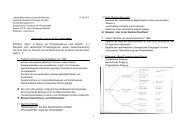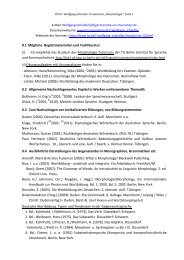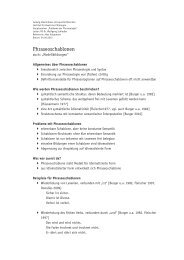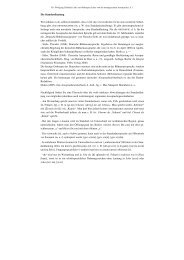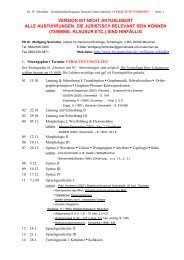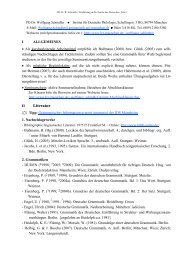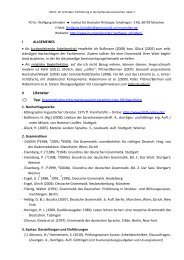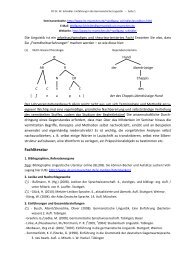Chapter 18 Lexical Functions: Description of Lexical Relations in a ...
Chapter 18 Lexical Functions: Description of Lexical Relations in a ...
Chapter 18 Lexical Functions: Description of Lexical Relations in a ...
Create successful ePaper yourself
Turn your PDF publications into a flip-book with our unique Google optimized e-Paper software.
—<strong>Chapter</strong> <strong>18</strong>. <strong>Lexical</strong> <strong>Functions</strong>— 95<br />
There are two more candidates for the status <strong>of</strong> simple standard LFs: Germ and Nocer,<br />
which have been played with for a long time; but today I th<strong>in</strong>k that it is not worth try<strong>in</strong>g to<br />
<strong>in</strong>troduce them <strong>in</strong>to the <strong>in</strong>ventory <strong>of</strong> Standard LFs.<br />
Germ (Lat. germen (embryo)) mean<strong>in</strong>g (germ, beg<strong>in</strong>n<strong>in</strong>g) is poorly represented:<br />
Fr. Germ(colère (anger)) = ferment, leva<strong>in</strong> (yeast) [de la ~], Germ(idea) = germ [<strong>of</strong> an ~]—and<br />
that’s about it: I cannot th<strong>in</strong>k <strong>of</strong> other good examples.<br />
Nocer (Lat. nocēre (do harm)) denotes a harmful action that the referent <strong>of</strong> L is supposed to<br />
do to a ‘victim’: <strong>in</strong> English, a bee st<strong>in</strong>gs and a snake bites, as well as a dog, but <strong>in</strong> French, a dog<br />
(bites) (mord), while a bee or a snake (picks) (pique 〈*mord〉); <strong>in</strong> Russian, a dog (bites) (kusaet),<br />
but a bee or a snake both (bites) (kusaet) or (st<strong>in</strong>gs) (žalit); <strong>in</strong> English, a car runs over/down a<br />
pedestrian, <strong>in</strong> Russian, it (crashes) (davit) him, and <strong>in</strong> French, it (mows) (fauche) him; and so<br />
forth. But, on the one hand, it seems that the possible arguments and values are not numerous<br />
enough; on the other hand, the necessary mean<strong>in</strong>g can be probably better described by a<br />
comb<strong>in</strong>ation <strong>of</strong> two LFs: AntiBon and Involv. Indeed, AntiBon 1Involv(automobile) could be<br />
strikes Y [a tree, a cement wall], smashes <strong>in</strong>to Y ((bad for itself) = (does harm to itself)), while<br />
AntiBon 2Involv(automobile) would then stand for runs Y over, strikes Y [a pedestrian], etc. I<br />
prefer the latter description as more analytical.<br />
For the reasons <strong>in</strong>dicated, I did not put these two LFs on my list.<br />
But, as has been said above, it is immaterial—<strong>in</strong> both practice and theory—whether we<br />
decide to treat an LF as standard or non-standard (cf. Polguère 200?).<br />
8 <strong>Lexical</strong> <strong>Functions</strong> <strong>in</strong> Computer Applications<br />
LFs were <strong>in</strong>vented <strong>in</strong> 1961, dur<strong>in</strong>g my participation—as a hired worker—<strong>in</strong> a geological<br />
expedition <strong>in</strong> Southern Kazakhstan semi-desert. Walk<strong>in</strong>g up and down stony hills, I was return-<br />
<strong>in</strong>g <strong>in</strong> my head one <strong>of</strong> well-known problems <strong>of</strong> mach<strong>in</strong>e translation: how to avoid or at least<br />
reduce tedious search for lexically-determ<strong>in</strong>ed contextual Russian equivalents <strong>of</strong> such English<br />
lexemes as IMPORTANT, EXTENSIVE, HEAVY, HIGH, on the one hand, and DO, MAKE, GIVE, GET,<br />
etc. on the other. That is how I figured out what later became Magn and Oper 1. This goal was<br />
clearly stated <strong>in</strong> Žolkovskij & Mel´čuk 1967; cf. also a specific proposal to this effect <strong>in</strong> Kula-<br />
g<strong>in</strong>a & Mel´čuk 1968: 301-302.<br />
It turned out later that LFs have, at the same time, an important theoretical status. For one<br />
th<strong>in</strong>g, they constitute the ‘miss<strong>in</strong>g l<strong>in</strong>k’ <strong>in</strong> the theory <strong>of</strong> phraseology, s<strong>in</strong>ce they are necessary to


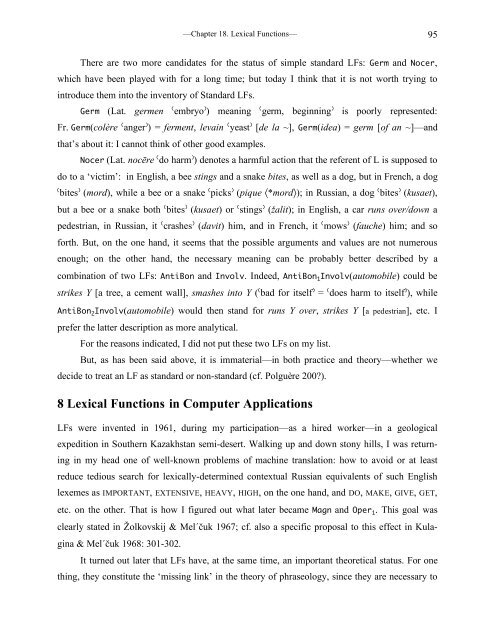
![E-Mail: Wolfgang.Schindler[ätt]germanistik.uni-muenchen.de Web ...](https://img.yumpu.com/51590147/1/184x260/e-mail-wolfgangschindlerattgermanistikuni-muenchende-web-.jpg?quality=85)
